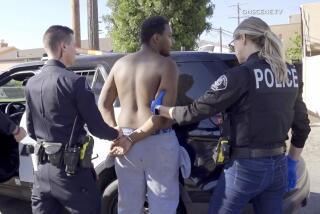Way Cleared for Retrial in Coin Shop Killings : Crime: Appeals curt rejects plea for a new preliminary hearing in the 1989 Newport Beach case.
- Share via
SANTA ANA — Though it scolded the prosecution for its conduct in the case, a state appeals court Wednesday cleared the way for the retrial of a former Tustin Marine improperly convicted of killing two people during the 1989 robbery of a Newport Beach coin shop.
In a 13-page ruling, the 4th District Court of Appeal rejected Thomas R. Merrill’s argument that he deserved a new preliminary hearing because prosecutors illegally withheld from the defense critical evidence pointing to his innocence.
Merrill’s two first-degree murder convictions were overturned on those grounds last year by Orange County Superior Court Commissioner Richard M. Aronson. But Aronson refused to grant Merrill a new preliminary hearing, a Municipal Court procedure to determine whether there is sufficient evidence to order a trial in Superior Court on felony charges.
“Justice was not done here. The error was substantial and material,” wrote Presiding Justice David G. Sills, noting that prosecutors failed to disclose important evidence during the case. Nevertheless, the appeals court ruled that Aronson had properly concluded there was enough justification to try Merrill based on circumstantial evidence.
Justices Edward J. Wallin and Sheila Sonenshine concurred in the opinion.
Deputy Dist. Atty. Eric W. Snethen, who challenged Merrill’s effort to win a new preliminary hearing, is on vacation and could not be reached for comment. Likewise, Merrill’s attorneys were unavailable for comment.
Merrill, who is serving two life sentences, and fellow Marine Eric J. Wick were convicted of murdering Clyde Oates and Renee King in March, 1989, at the Newport Beach Coin Exchange. King’s husband, Bill, was seriously wounded in the head.
Merrill’s mother, Sara, said she found the decision “disgusting. I seem to remember the justices said (during oral arguments) that you could give Tom a new prelim and continue with the case. Keeping an innocent man in prison for six months is totally, totally outrageous.”
Merrill’s lawyers, William J. Genego and John D. Barnett, argued that because the prosecution withheld evidence Merrill was denied a chance to show during his first preliminary hearing that he is innocent.
The evidence in question involves a key eyewitness who says he told former Deputy Dist. Atty. Jeoffrey L. Robinson and his investigator Gerald Teplansky that Merrill was not one of the two men he had seen fleeing the coin shop.
The witness, baker Finn Olsen, says he told prosecutors this shortly before Merrill’s first preliminary hearing at which he was to testify. He said Robinson then told him to go home and that he would not be needed.
According to Olsen, the prosecutor tried to coach him into saying that his inability to identify Merrill was due to an uncertain memory, failure to adequately observe the killers or even a mistake.
When the effort to dissuade Olsen failed, the deputy district attorney and his investigator supposedly asked Olsen not to “volunteer” the information on the witness stand, court records state.
Robinson, now in private practice, has denied any wrongdoing. He contends that Olsen simply could not identify Merrill, which is far different from saying Merrill was not one of the men he had seen.
When Aronson overturned Merrill’s conviction, he did not resolve the disagreement, though he concluded--without assessing specific blame--that evidence had been withheld by the prosecution.
“Nonetheless, the facts alleged, if true, present an appalling picture of official malfeasance,” Sills wrote. “Private parties have found themselves embroiled in litigation over spoilation of evidence based on much less than that alleged by Olsen.”
Justices said the suppression of evidence resulted in “a great waste of time” because a new trial had to be ordered. However, they confined their scolding to Robinson and Teplansky, not wanting to imply that the case was representative of the way prosecutions are conducted by the Orange County district attorney’s office.
More to Read
Sign up for Essential California
The most important California stories and recommendations in your inbox every morning.
You may occasionally receive promotional content from the Los Angeles Times.














